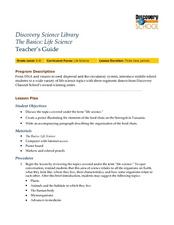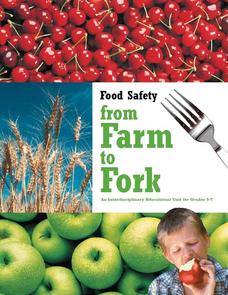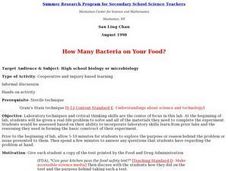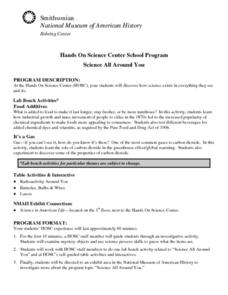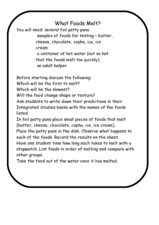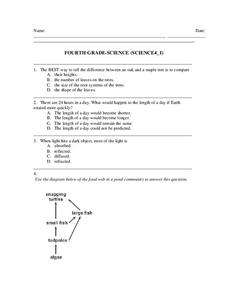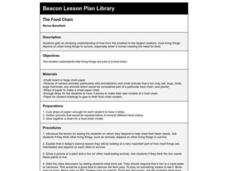Curated OER
Hedgerows
Hedgerows prevent soil erosion, capture pollutants running off fields, store carbon to help combat climate change, and provide homes for predators of many pest species. The biodiversity lesson begins with an activity that...
Field Museum
The Case of Darwin's Finches
One of the most striking pieces of evidence for Darwin's Evolution of Species was his observations of finches and how their beaks differed from island to island, depending on their primary food sources. So what would happen to the theory...
Virginia Department of Education
The Effects of Heat and Acid on the Enzyme Catalase
How quickly do enzymatic reactions occur? Assist the class as they examine heat and pH change to determine the rate of chemical reactions using catalase as an enzyme. Watch them "glow" with excitement!
Curated OER
Unit: Home: Examination Five
Write short answers or fill in the blank to the following questions and statements. Use complete sentences when answering questions. Questions included are, but not limiterd to Why should raw and cooked foods be stored separately in the...
Curated OER
Nutrition: How Much Fat Am I Eating?
How much fat is in this? Scholars first read some background information on the caloric content of fats versus carbohydrates, and then use that knowledge to analyze foods they regularly eat. They will look at 5 package labels for the...
Curated OER
Growing Cress: Sprouts
What does it take to grow a healthy plant? Budding horticulturists will look at each slide and consider which conditions produced the best results. Slides contain images of plants that have had too much or too little water, light, or...
Curated OER
The Basics: Life Science
Young scholars develop an understanding of the different fields of study that are encompassed by the term, life science. They view and discuss a video on the topic. In small groups they focus on on of the examples shown in the video to...
Curated OER
Food Safety From Food To Fork
Pupils are introduced to the concept of food safety. In groups, they distinguish between fact and opinion and cause and effect while participating in a board game. They write an essay about what knowledge they gained and review the...
Curated OER
Food Web Follies
Seventh graders cut and paste animal pictures to create a food web and trace the path of energy. They write a paragraph explaining the importance of photosynthesis in all food webs.
Curated OER
Science Processes
Fifth graders observe a dry piece of bread and a damp piece of bread in two separate sealed bags that have been sitting for several days that have been labeled. The observe the mold with a hand lens and record findings in their science...
Curated OER
How Many Bacteria on Your Food?
High schoolers discuss and conduct a food safety experiment which looks at bacteria and food poisoning. They swab the other area of some food and grow bacteria in an agar plate.
Curated OER
Energy Crossword
In this science worksheet, students solve the crossword puzzle using the context of energy to acquire a new understanding of vocabulary words.
Curated OER
Science All Around You
Students visit and explore a Hands On Science Center (HOSC). They participate in a variety of self-guided table exercises and observe as scientists demonstrate various scientific principles.
Curated OER
What Foods Melt?
In this science learning exercise, students experiment to determine which foods melt using hot water in metal pans. They write predictions about which foods will melt and which will melt the fastest. They perform the experiment and note...
Curated OER
Fourth Grade Science
In this science learning exercise, 4th graders complete multiple choice questions about day lengths, light and dark, food, recycling, and more. Students complete 25 questions.
Curated OER
Vermiculture Food Waste Compost Program for Touchstone School
Learners explore the advantages of composting. In this recycling lesson students complete a worm compost project and collect food waste to feed them.
Curated OER
The Food Chain
First graders explore how most living things, big and small, need food for survival.
Curated OER
Growing Our Own Food: Sustainable Agriculture
Students identify the common food items in their community, plant a small garden and discuss how agriculture has helped growing nations.
Curated OER
Valentine Science Blood Types
Students explore blood types. In this science investigation lesson, students participate in a classroom simulation that replicates a blood transfusion so that students may note how the 4 blood types interact.
Curated OER
Wetlands - Food Web Relationships
In this food web relationships worksheet, students click on the links to learn about the food web relationships in the wetlands and answer short answer questions about it. Students complete 8 questions total.
Curated OER
Thank You For the Food We Eat
Students explore where our food comes from. In this science lesson, students discuss how much of our food comes from animals. Students construct a mobile.
Curated OER
What Foods Contain Products from the Ocean
Fifth graders learn about foods from the ocean. In this ocean products activity, 5th graders brainstorm what foods come from the ocean, fill in a Venn Diagram comparing alginates, carrageenans and beta carotenes. Students...
Curated OER
Farm Animals And Food They Eat
Students identify farm animals by the sounds they make and draw the animal and type of food they eat. In this farm animals lesson plan, students read the book Barnyard Song and view baggies of animal food.
Curated OER
Fishing for Foods
Students practice using the food pyramid and know which food group familiar foods belong in.
Other popular searches
- Science Project Food
- Science Animal Food Chain
- Food Science Experiments
- Food Science Vocabulary
- Food Science Careers
- Consumer Science Food
- Spanish Food Science
- Simple Food Science
- Food Science Service Project
- Food Science Nutrition
- Nutrition and Food Science
- Food Science Lesson Plan






